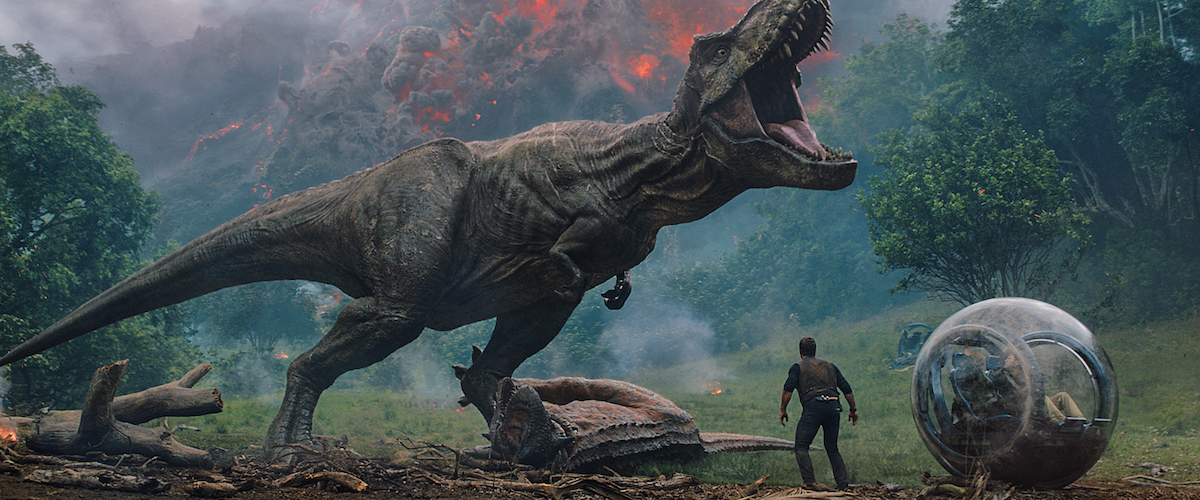How should a dinosaur movie be? The makers of the first dinosaur movies, clearly drunk on their imaginations and the way their visions could be realized with then-new effects technology, did not have the self-consciousness to ask the question. The two early landmarks, 1925’s “The Lost World” and 1933’s “King Kong,” in which the giant creatures roamed the modern world courtesy of stop-motion animation conceived and executed by Willis O’Brien, were straightforward spectacles with nasty racialized touches, but they’re still valid (and in many respects thrilling) because they do their jobs: creation and destruction, things you’ve never seen before wreaking havoc on the world you live in.
Reviewing the 1993 “Jurassic Park,” my friend and colleague Janet Maslin wrote about the film’s potent frights and then added: “Much scarier, however, are those aspects of ‘Jurassic Park’ that establish it as the overnight flagship of a brand-new entertainment empire. Even while capturing the imagination of its audience, this film lays the groundwork for the theme-park rides, sequels and souvenirs that insure the ‘Jurassic Park’ experience will live on. And on. And on.”
While “King Kong” spawned one sort-of sequel, and a spinoff, and a couple of remakes, what Maslin was talking about here was something different, and has absolutely come to pass. As such, what a dinosaur movie should be is now, with “Jurassic World: Fallen Kingdom,” what the entertainment empire demands.
Directed by J.A. Bayona from a script by Colin Trevorrow and Derek Connolly, “Fallen Kingdom” opens with a few DNA pirates on a stealth mission at the now-abandoned-by-humans island park where the dinosaurs still roam. These bootleggers get away, not quite clean, of course, because we need the pre-credits chomping sequence the way a Bond movie needs a non-diegetic stunt opener. After this we learn that a volcano is about to rock said island and make fossils of all the lizards once more. Should they be saved? Jeff Goldblum’s Dr. Malcolm speaks to a congressional committee with metaphors that limn a global-warming allegory—the only time the movie tries to make anything resembling a statement—and says, let nature take its course. Bryce Dallas Howard’s Claire, however, now running a save-the-dinosaurs nonprofit, is frustrated by congressional inaction and heartened by a call from Eli Mills, who’s now running the concern that manufactured the dinos in the first place. Mills, played by Rafe Spall as if channeling Alessandro Nivola, shows Claire a new sanctuary he’s carved out for the creatures. He has a particular interest in super-smart raptor “Blue,” who was so sensitively trained by Chris Pratt’s Owen.
So yes, we’re getting the band back together. Joining up are two new members, from Claire’s crew: feisty dino-medic Zia Rodriguez—Daniella Pineda, whom some may recognize from the indie comedy “Mr. Roosevelt”—and computer nerd Franklin, played by Justice Smith in a characterization that suggests TV’s Urkel as reimagined by Wes Anderson. Once on the island whilst dodging dinosaurs and lava—“Oh God, it’s hot!” “It’s about to get a whole lot hotter.”— the foursome discovers a double cross perpetrated by a head hunter played by Ted Levine. After nearly drowning in a pod, dodging balls of hot lava, and fleeing other CGI-generated perils, Claire and Owen and party stow away on the ship transporting captured dinosaurs to who knows where. After a refreshing sleep, the two leads awake with perfect hair and makeup and not a scuff on their skins or clothing. I know it’s pointless to complain about realism in movies such as these but I laughed.
The movie then shifts in tone and structure, from a standard out-of-doors mayhem fest to a Gothic mansion tale—Charlotte Bronte with thunder lizards. I’m not kidding here. This is the section where director Bayona gets to flex whatever muscle his corporate overlords permitted him to muster. Mills operates from the estate of mega-millionaire Benjamin Lockwood (James Cromwell)—a supposed partner of John Hammond who wants to carry on the great work yada yada yada. But Mills’ vision is very different from Hammond’s or Lockwood’s. He wants to weaponize the engineered creatures, and the mansion is to be the site of a grand auction of the captured animals. There’s no sanctuary.
Throwing a spanner in Mills’ works is Maisie, Hammond’s bright but enigmatic granddaughter. (Here the screenwriters want to get a little cute, as much of the action hinges on what Maisie knows, or at least finds out.) Cared for by an equally enigmatic nanny (played by Geraldine Chaplin, a regular presence in Bayona’s pictures, including the terrific 2007 “The Orphanage”), Maisie’s just crazy about dinos, although she may have second thoughts if the vicious “Indoraptor” that Mills and B.D. Wong’s Dr. Wu have bred in the basement gets loose. Which of course it does.
The film stomps through its two-hour running time hitting a lot of action beats that the series has hit before; the variations therein are along the lines of equations you used to do for homework: D (dinosaurs) over VE (volcanic eruption) times 4 characters the audience may or may not have any emotional investment in equals effective sequence, especially given the precision of the special effects. Here, then, is what the dinosaur movie is: bloodless, soulless, bereft of personality or idiosyncrasy, delivering only meticulously engineered thrills based on repeating what has worked in the past.
This is a movie that’s annoying in part because it doesn’t care if you’re annoyed by it. It doesn’t need you, the individual viewer, to like it. It just needs a crowd to see it. Whether you’ve been entertained or enlightened is immaterial. It’s Barnum time. You don’t like it? This way to the egress.




















